ignition Seat Cordoba 2007 Owner's Manual
[x] Cancel search | Manufacturer: SEAT, Model Year: 2007, Model line: Cordoba, Model: Seat Cordoba 2007Pages: 256, PDF Size: 7.75 MB
Page 5 of 256
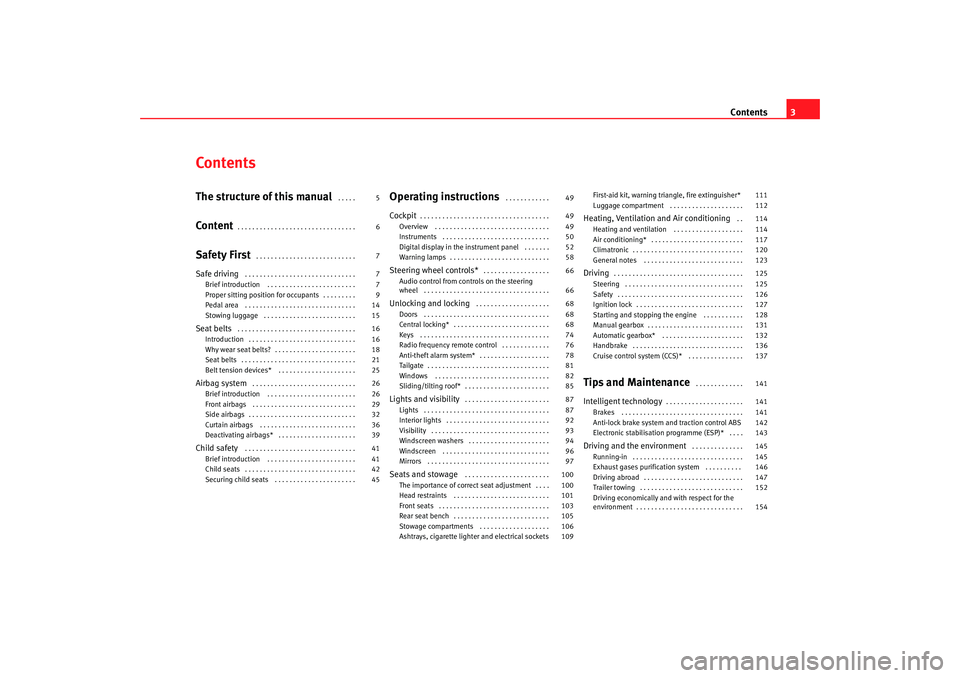
Contents3
ContentsThe structure of this manual
. . . . .
Content
. . . . . . . . . . . . . . . . . . . . . . . . . . . . . . . .
Safety First
. . . . . . . . . . . . . . . . . . . . . . . . . . .
Safe driving
. . . . . . . . . . . . . . . . . . . . . . . . . . . . . .
Brief introduction . . . . . . . . . . . . . . . . . . . . . . . .
Proper sitting position for occupants . . . . . . . . .
Pedal area . . . . . . . . . . . . . . . . . . . . . . . . . . . . . .
Stowing luggage . . . . . . . . . . . . . . . . . . . . . . . . .
Seat belts
. . . . . . . . . . . . . . . . . . . . . . . . . . . . . . . .
Introduction . . . . . . . . . . . . . . . . . . . . . . . . . . . . .
Why wear seat belts? . . . . . . . . . . . . . . . . . . . . . .
Seat belts . . . . . . . . . . . . . . . . . . . . . . . . . . . . . . .
Belt tension devices* . . . . . . . . . . . . . . . . . . . . .
Airbag system
. . . . . . . . . . . . . . . . . . . . . . . . . . . .
Brief introduction . . . . . . . . . . . . . . . . . . . . . . . .
Front airbags . . . . . . . . . . . . . . . . . . . . . . . . . . . .
Side airbags . . . . . . . . . . . . . . . . . . . . . . . . . . . . .
Curtain airbags . . . . . . . . . . . . . . . . . . . . . . . . . .
Deactivating airbags* . . . . . . . . . . . . . . . . . . . . .
Child safety
. . . . . . . . . . . . . . . . . . . . . . . . . . . . . .
Brief introduction . . . . . . . . . . . . . . . . . . . . . . . .
Child seats . . . . . . . . . . . . . . . . . . . . . . . . . . . . . .
Securing child seats . . . . . . . . . . . . . . . . . . . . . .
Operating instructions
. . . . . . . . . . . .
Cockpit
. . . . . . . . . . . . . . . . . . . . . . . . . . . . . . . . . . .
Overview . . . . . . . . . . . . . . . . . . . . . . . . . . . . . . .
Instruments . . . . . . . . . . . . . . . . . . . . . . . . . . . . .
Digital display in the instrument panel . . . . . . .
Warning lamps . . . . . . . . . . . . . . . . . . . . . . . . . . .
Steering wheel controls*
. . . . . . . . . . . . . . . . . .
Audio control from controls on the steering
wheel . . . . . . . . . . . . . . . . . . . . . . . . . . . . . . . . . .
Unlocking and locking
. . . . . . . . . . . . . . . . . . . .
Doors . . . . . . . . . . . . . . . . . . . . . . . . . . . . . . . . . .
Central locking* . . . . . . . . . . . . . . . . . . . . . . . . . .
Keys . . . . . . . . . . . . . . . . . . . . . . . . . . . . . . . . . . .
Radio frequency remote control . . . . . . . . . . . . .
Anti-theft alarm system* . . . . . . . . . . . . . . . . . . .
Tailgate . . . . . . . . . . . . . . . . . . . . . . . . . . . . . . . . .
Windows . . . . . . . . . . . . . . . . . . . . . . . . . . . . . . .
Sliding/tilting roof* . . . . . . . . . . . . . . . . . . . . . . .
Lights and visibility
. . . . . . . . . . . . . . . . . . . . . . .
Lights . . . . . . . . . . . . . . . . . . . . . . . . . . . . . . . . . .
Interior lights . . . . . . . . . . . . . . . . . . . . . . . . . . . .
Visibility . . . . . . . . . . . . . . . . . . . . . . . . . . . . . . . .
Windscreen washers . . . . . . . . . . . . . . . . . . . . . .
Windscreen . . . . . . . . . . . . . . . . . . . . . . . . . . . . .
Mirrors . . . . . . . . . . . . . . . . . . . . . . . . . . . . . . . . .
Seats and stowage
. . . . . . . . . . . . . . . . . . . . . . .
The importance of correct seat adjustment . . . .
Head restraints . . . . . . . . . . . . . . . . . . . . . . . . . .
Front seats . . . . . . . . . . . . . . . . . . . . . . . . . . . . . .
Rear seat bench . . . . . . . . . . . . . . . . . . . . . . . . . .
Stowage compartments . . . . . . . . . . . . . . . . . . .
Ashtrays, cigarette lighter and electrical sockets First-aid kit, warning triangle, fire extinguisher*
Luggage compartment . . . . . . . . . . . . . . . . . . . .
Heating, Ventilation and Air conditioning
. .
Heating and ventilation . . . . . . . . . . . . . . . . . . .
Air conditioning* . . . . . . . . . . . . . . . . . . . . . . . . .
Climatronic . . . . . . . . . . . . . . . . . . . . . . . . . . . . . .
General notes . . . . . . . . . . . . . . . . . . . . . . . . . . .
Driving
. . . . . . . . . . . . . . . . . . . . . . . . . . . . . . . . . . .
Steering . . . . . . . . . . . . . . . . . . . . . . . . . . . . . . . .
Safety . . . . . . . . . . . . . . . . . . . . . . . . . . . . . . . . . .
Ignition lock . . . . . . . . . . . . . . . . . . . . . . . . . . . . .
Starting and stopping the engine . . . . . . . . . . .
Manual gearbox . . . . . . . . . . . . . . . . . . . . . . . . . .
Automatic gearbox* . . . . . . . . . . . . . . . . . . . . . .
Handbrake . . . . . . . . . . . . . . . . . . . . . . . . . . . . . .
Cruise control system (CCS)* . . . . . . . . . . . . . . .
Tips and Maintenance
. . . . . . . . . . . . .
Intelligent technology
. . . . . . . . . . . . . . . . . . . . .
Brakes . . . . . . . . . . . . . . . . . . . . . . . . . . . . . . . . .
Anti-lock brake system and traction control ABS
Electronic stabilisation programme (ESP)* . . . .
Driving and the environment
. . . . . . . . . . . . . .
Running-in . . . . . . . . . . . . . . . . . . . . . . . . . . . . . .
Exhaust gases purification system . . . . . . . . . .
Driving abroad . . . . . . . . . . . . . . . . . . . . . . . . . . .
Trailer towing . . . . . . . . . . . . . . . . . . . . . . . . . . . .
Driving economically and with respect for the
environment . . . . . . . . . . . . . . . . . . . . . . . . . . . . .
5
6
7
7
7
9
14
15
16
16
18
21
25
26
26
29
32
36
39
41
41
42
45 49
49
49
50
52
58
66
66
68
68
68
74
76
78
81
82
85
87
87
92
93
94
96
97
100
100
101
103
105
106
109 111
112
114
114
117
120
123
125
125
126
127
128
131
132
136
137
141
141
141
142
143
145
145
146
147
152
154
cordoba_ingles_0706 Seite 3 Montag, 28. August 2006 1:18 13
Page 19 of 256
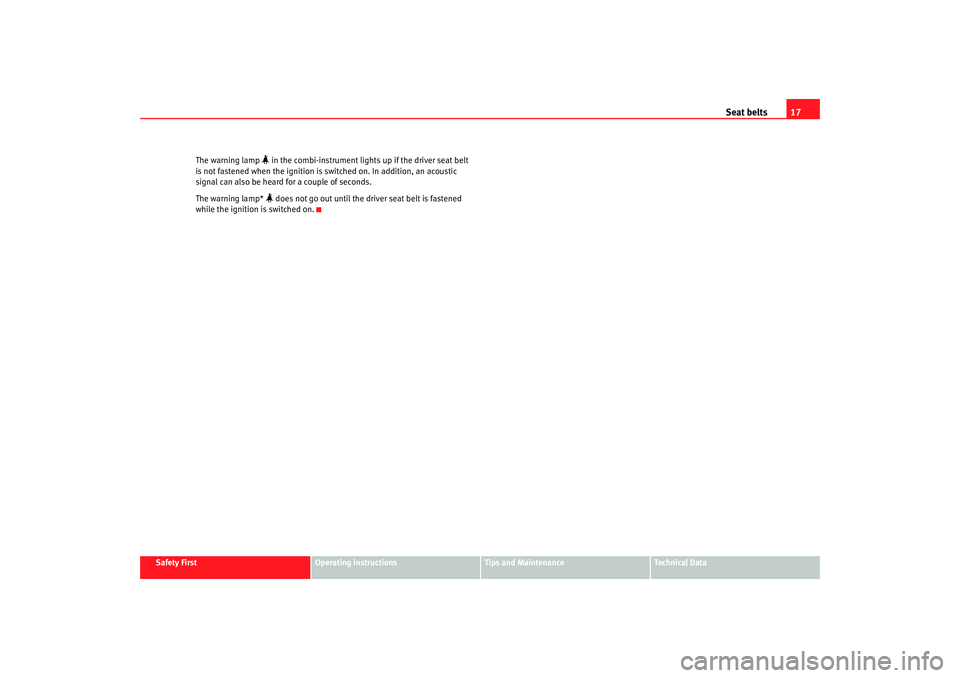
Seat belts17
Safety First
Operating instructions
Tips and Maintenance
Te c h n i c a l D a t a
The warning lamp
in the combi-instrument lights up if the driver seat belt
is not fastened when the ignition is switched on. In addition, an acoustic
signal can also be heard for a couple of seconds.
The warning lamp* does not go out until the driver seat belt is fastened
while the ignition is switched on.
cordoba_ingles_0706 Seite 17 Montag, 28. August 2006 1:18 13
Page 30 of 256
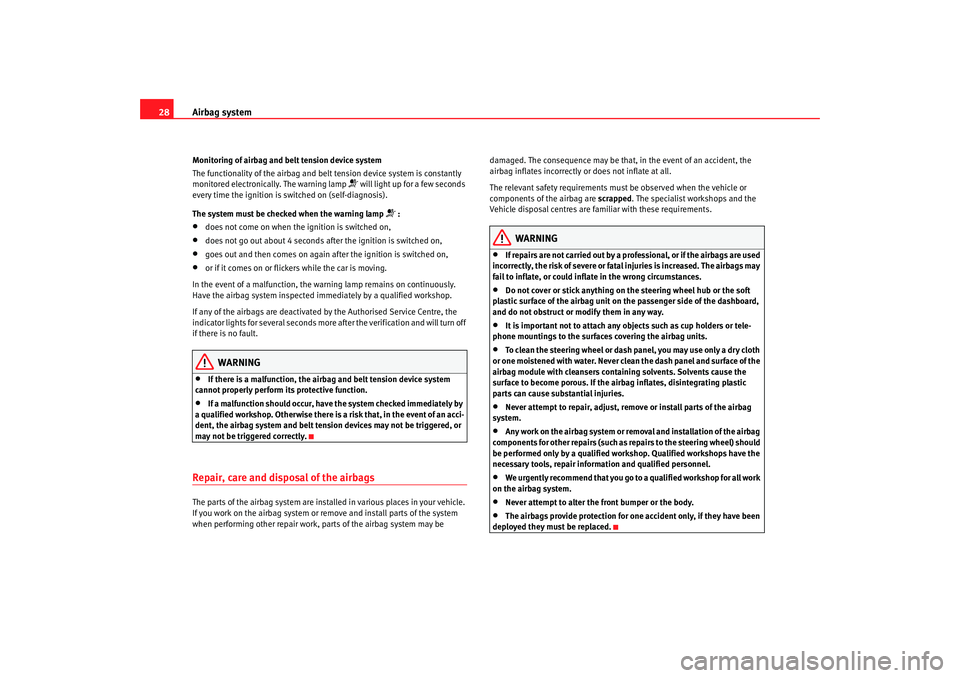
Airbag system
28Monitoring of airbag and belt tension device system
The functionality of the airbag and belt tension device system is constantly
monitored electronically. The warning lamp
will light up for a few seconds
every time the ignition is switched on (self-diagnosis).
The system must be checked when the warning lamp
:
•
does not come on when the ignition is switched on,
•
does not go out about 4 seconds after the ignition is switched on,
•
goes out and then comes on again after the ignition is switched on,
•
or if it comes on or flickers while the car is moving.
In the event of a malfunction, the warning lamp remains on continuously.
Have the airbag system inspected immediately by a qualified workshop.
If any of the airbags are deactivated by the Authorised Service Centre, the
indicator lights for several seconds more after the veri fication and will turn off
if there is no fault.
WARNING
•
If there is a malfunction, the air bag and belt tension device system
cannot properly perform its protective function.
•
If a malfunction should occur, have the system checked immediately by
a qualified workshop. Otherwise there is a risk that, in the event of an acci-
dent, the airbag system and belt tension devices may not be triggered, or
may not be triggered correctly.
Repair, care and disposal of the airbagsThe parts of the airbag system are installed in various places in your vehicle.
If you work on the airbag system or remove and install parts of the system
when performing other repair work, parts of the airbag system may be damaged. The consequence may be that, in the event of an accident, the
airbag inflates incorrectly
or does not inflate at all.
The relevant safety requirements must be observed when the vehicle or
components of the airbag are scrapped. The specialist workshops and the
Vehicle disposal centres are familiar with these requirements.
WARNING
•
If repairs are not carried out by a professional, or if the airbags are used
incorrectly, the risk of severe or fatal injuries is increased. The airbags may
fail to inflate, or could inflate in the wrong circumstances.
•
Do not cover or stick anything on the steering wheel hub or the soft
plastic surface of the airbag unit on the passenger side of the dashboard,
and do not obstruct or modify them in any way.
•
It is important not to attach any objects such as cup holders or tele-
phone mountings to the surfaces covering the airbag units.
•
To clean the steering wheel or dash panel, you may use only a dry cloth
or one moistened with water. Never clean the dash panel and surface of the
airbag module with cleansers containing solvents. Solvents cause the
surface to become porous. If the airbag inflates, disintegrating plastic
parts can cause substantial injuries.
•
Never attempt to repair, adjust, remove or install parts of the airbag
system.
•
Any work on the airbag system or re moval and installation of the airbag
components for other repairs (such as repairs to the steering wheel) should
be performed only by a qualified workshop. Qualified workshops have the
necessary tools, repair information and qualified personnel.
•
We urgently recommend that you go to a qualified workshop for all work
on the airbag system.
•
Never attempt to alter the front bumper or the body.
•
The airbags provide protection for one accident only, if they have been
deployed they must be replaced.
cordoba_ingles_0706 Seite 28 Montag, 28. August 2006 1:18 13
Page 31 of 256
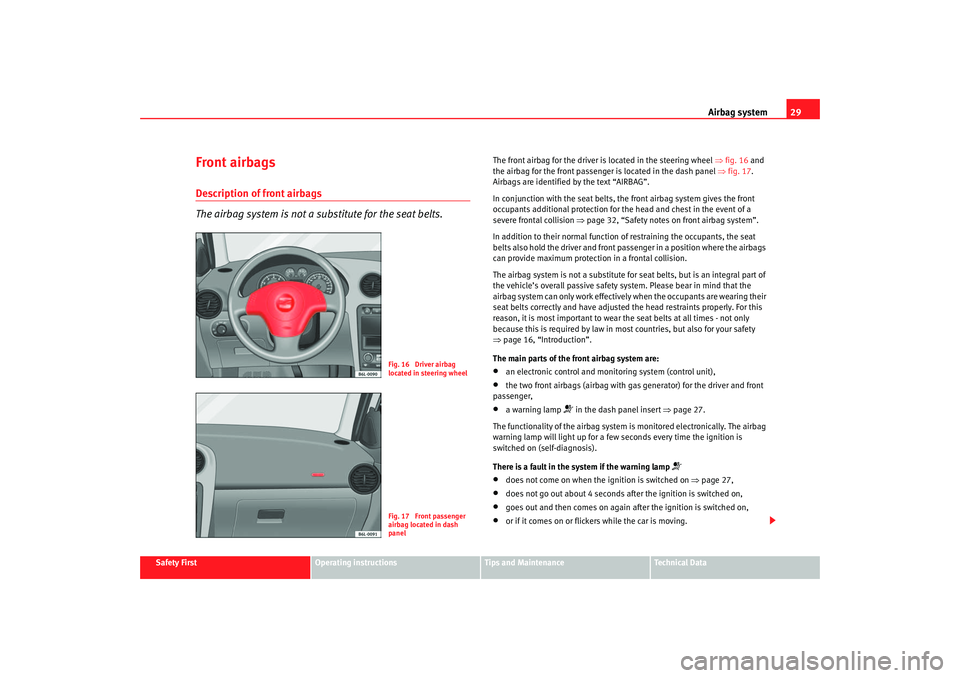
Airbag system29
Safety First
Operating instructions
Tips and Maintenance
Te c h n i c a l D a t a
Front airbagsDescription of front airbags
The airbag system is not a substitute for the seat belts.
The front airbag for the driver is located in the steering wheel ⇒fig. 16 and
the airbag for the front passenger is located in the dash panel ⇒fig. 17 .
Airbags are identified by the text “AIRBAG”.
In conjunction with the seat belts, the front airbag system gives the front
occupants additional protection for the head and chest in the event of a
severe frontal collision ⇒page 32, “Safety notes on front airbag system”.
In addition to their normal function of restraining the occupants, the seat
belts also hold the driver and front pas senger in a position where the airbags
can provide maximum protection in a frontal collision.
The airbag system is not a substitute for seat belts, but is an integral part of
the vehicle’s overall passive safety system. Please bear in mind that the
airbag system can only work effectively when the occupants are wearing their
seat belts correctly and have adjusted the head restraints properly. For this
reason, it is most important to wear the seat belts at all times - not only
because this is required by law in most countries, but also for your safety
⇒ page 16, “Introduction”.
The main parts of the front airbag system are:•
an electronic control and monitoring system (control unit),
•
the two front airbags (airbag with gas generator) for the driver and front
passenger,
•
a warning lamp
in the dash panel insert ⇒page 27.
The functionality of the airbag system is monitored electronically. The airbag
warning lamp will light up for a few seconds every time the ignition is
switched on (self-diagnosis).
There is a fault in the system if the warning lamp
•
does not come on when the ignition is switched on ⇒page 27,
•
does not go out about 4 seconds after the ignition is switched on,
•
goes out and then comes on again after the ignition is switched on,
•
or if it comes on or flickers while the car is moving.
Fig. 16 Driver airbag
located in steering wheelFig. 17 Front passenger
airbag located in dash
panel
cordoba_ingles_0706 Seite 29 Montag, 28. August 2006 1:18 13
Page 32 of 256
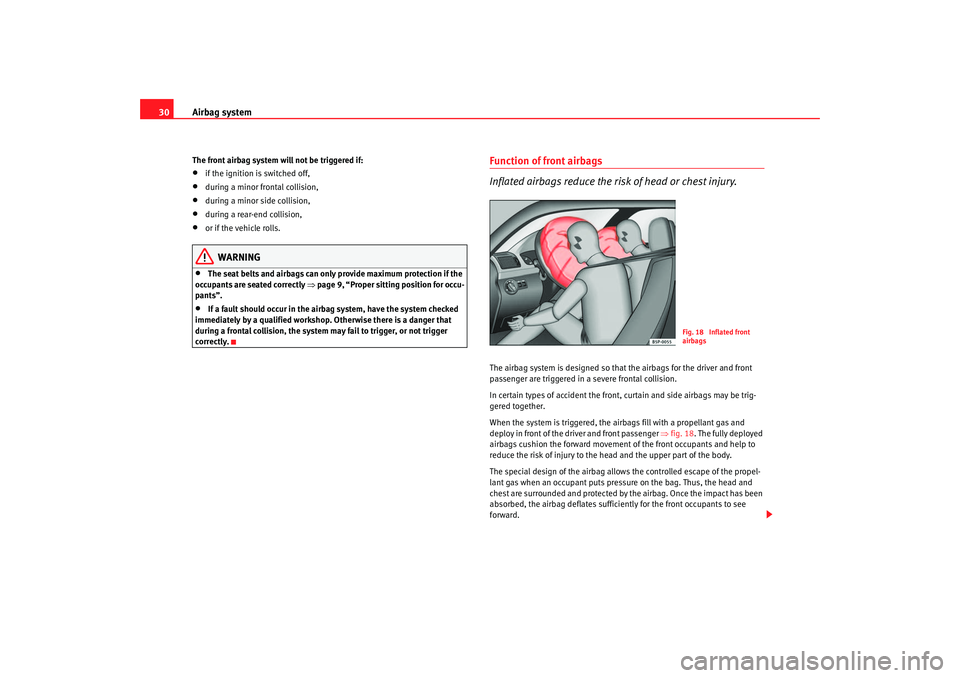
Airbag system
30The front airbag system will not be triggered if:•
if the ignition is switched off,
•
during a minor frontal collision,
•
during a minor side collision,
•
during a rear-end collision,
•
or if the vehicle rolls.
WARNING
•
The seat belts and airbags can only provide maximum protection if the
occupants are seated correctly ⇒ page 9, “Proper sitting position for occu-
pants”.
•
If a fault should occur in the airbag system, have the system checked
immediately by a qualified workshop. Otherwise there is a danger that
during a frontal collision, the system may fail to trigger, or not trigger
correctly.
Function of front airbags
Inflated airbags reduce the risk of head or chest injury.The airbag system is designed so that the airbags for the driver and front
passenger are triggered in a severe frontal collision.
In certain types of accident the front, curtain and side airbags may be trig-
gered together.
When the system is triggered, the airbags fill with a propellant gas and
deploy in front of the driver and front passenger ⇒fig. 18 . The fully deployed
airbags cushion the forward movement of the front occupants and help to
reduce the risk of injury to the head and the upper part of the body.
The special design of the airbag allows the controlled escape of the propel-
lant gas when an occupant puts pressure on the bag. Thus, the head and
chest are surrounded and protected by th e airbag. Once the impact has been
absorbed, the airbag deflates sufficiently for the front occupants to see
forward.
Fig. 18 Inflated front
airbags
cordoba_ingles_0706 Seite 30 Montag, 28. August 2006 1:18 13
Page 35 of 256
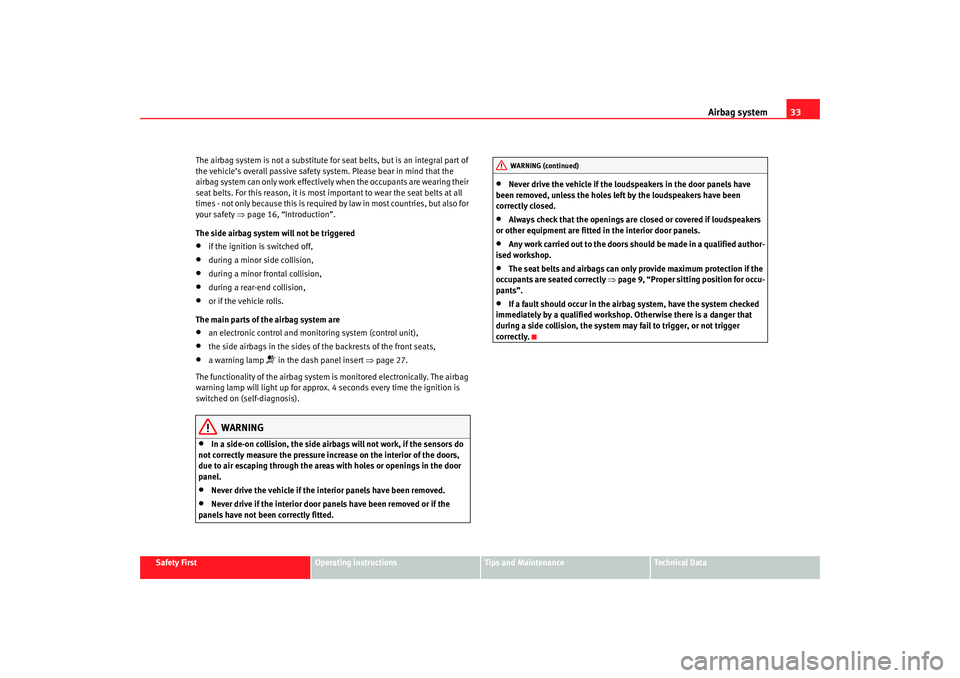
Airbag system33
Safety First
Operating instructions
Tips and Maintenance
Te c h n i c a l D a t a
The airbag system is not a substitute for seat belts, but is an integral part of
the vehicle’s overall passive safety system. Please bear in mind that the
airbag system can only work effectively when the occupants are wearing their
seat belts. For this reason, it is most important to wear the seat belts at all
times - not only because this is required
by law in most countries, but also for
your safety ⇒page 16, “Introduction”.
The side airbag system will not be triggered
•
if the ignition is switched off,
•
during a minor side collision,
•
during a minor frontal collision,
•
during a rear-end collision,
•
or if the vehicle rolls.
The main parts of the airbag system are
•
an electronic control and monitoring system (control unit),
•
the side airbags in the sides of the backrests of the front seats,
•
a warning lamp
in the dash panel insert ⇒page 27.
The functionality of the airbag system is monitored electronically. The airbag
warning lamp will light up for approx. 4 seconds every time the ignition is
switched on (self-diagnosis).
WARNING
•
In a side-on collision, the side air bags will not work, if the sensors do
not correctly measure the pressure incr ease on the interior of the doors,
due to air escaping through the areas with holes or openings in the door
panel.
•
Never drive the vehicle if the interior panels have been removed.
•
Never drive if the interior door panels have been removed or if the
panels have not been correctly fitted.
•
Never drive the vehicle if the loudspeakers in the door panels have
been removed, unless the holes left by the loudspeakers have been
correctly closed.
•
Always check that the openings are closed or covered if loudspeakers
or other equipment are fitted in the interior door panels.
•
Any work carried out to the doors should be made in a qualified author-
ised workshop.
•
The seat belts and airbags can only provide maximum protection if the
occupants are seated correctly ⇒ page 9, “Proper sitting position for occu-
pants”.
•
If a fault should occur in the airbag system, have the system checked
immediately by a qualified workshop. Otherwise there is a danger that
during a side collision, the system may fail to trigger, or not trigger
correctly.WARNING (continued)
cordoba_ingles_0706 Seite 33 Montag, 28. August 2006 1:18 13
Page 38 of 256
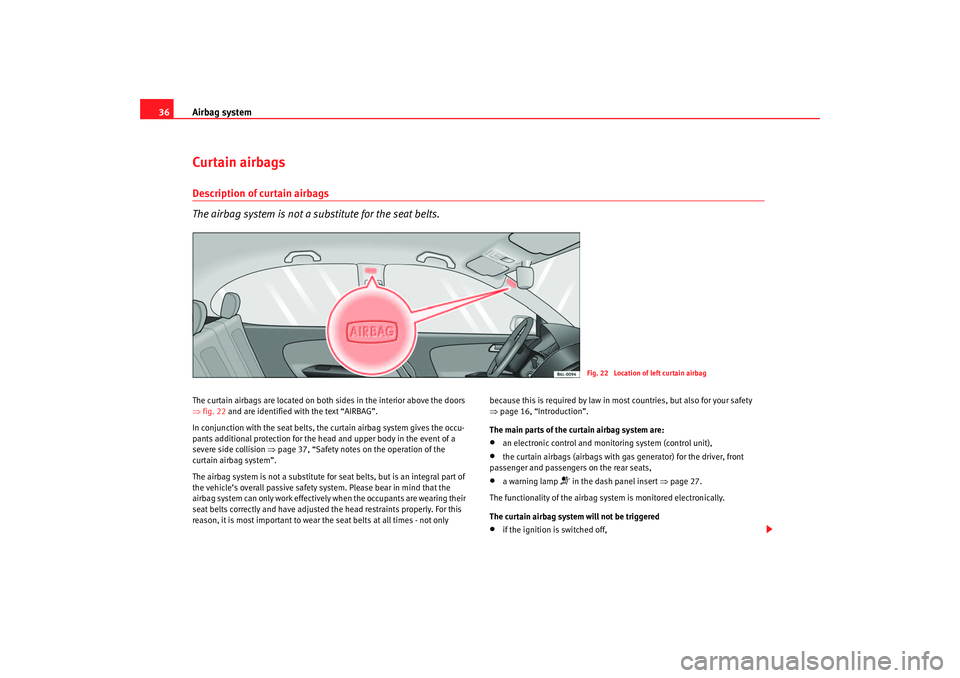
Airbag system
36Curtain airbagsDescription of curtain airbags
The airbag system is not a substitute for the seat belts.The curtain airbags are located on both sides in the interior above the doors
⇒ fig. 22 and are identified with the text “AIRBAG”.
In conjunction with the seat belts, the curtain airbag system gives the occu-
pants additional protection for the head and upper body in the event of a
severe side collision ⇒ page 37, “Safety notes on the operation of the
curtain airbag system”.
The airbag system is not a substitute for seat belts, but is an integral part of
the vehicle’s overall passive safety system. Please bear in mind that the
airbag system can only work effectively when the occupants are wearing their
seat belts correctly and have adjusted the head restraints properly. For this
reason, it is most important to wear the seat belts at all times - not only because this is required by law in most
countries, but also for your safety
⇒ page 16, “Introduction”.
The main parts of the curtain airbag system are:
•
an electronic control and monitoring system (control unit),
•
the curtain airbags (airbags with ga s generator) for the driver, front
passenger and passengers on the rear seats,
•
a warning lamp
in the dash panel insert ⇒ page 27.
The functionality of the airbag system is monitored electronically.
The curtain airbag system will not be triggered
•
if the ignition is switched off,
Fig. 22 Location of left curtain airbag
cordoba_ingles_0706 Seite 36 Montag, 28. August 2006 1:18 13
Page 41 of 256
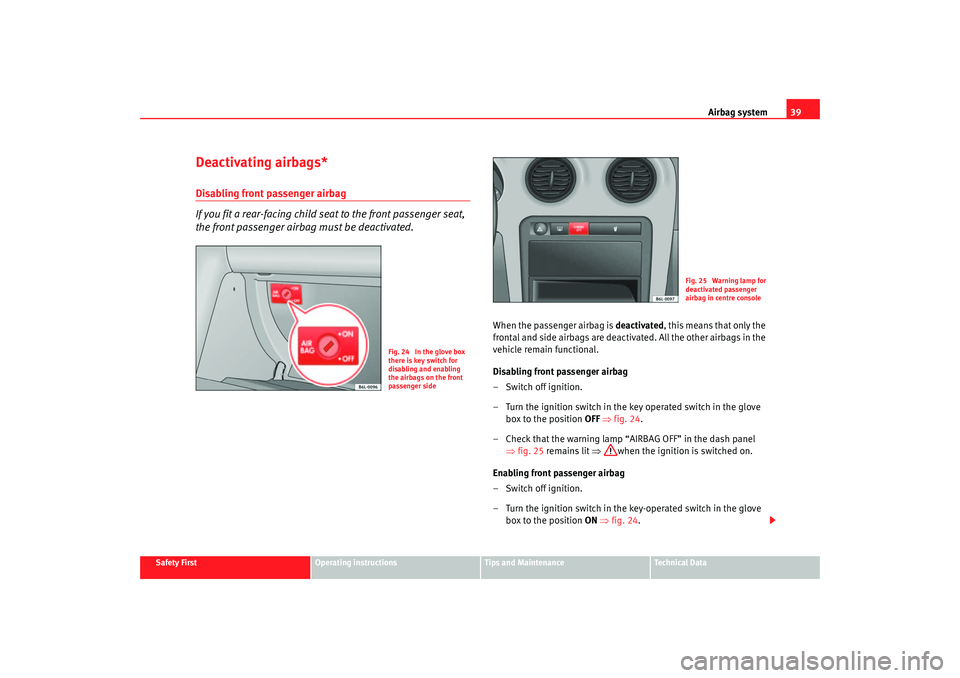
Airbag system39
Safety First
Operating instructions
Tips and Maintenance
Te c h n i c a l D a t a
Deactivating airbags*Disabling front passenger airbag
If you fit a rear-facing child seat to the front passenger seat,
the front passenger airbag must be deactivated.
When the passenger airbag is deactivated, this means that only the
frontal and side airbags are deactivated. All the other airbags in the
vehicle remain functional.
Disabling front passenger airbag
– Switch off ignition.
– Turn the ignition switch in the key operated switch in the glove box to the position OFF ⇒ fig. 24 .
– Check that the warning lamp “AIRBAG OFF” in the dash panel ⇒fig. 25 remains lit ⇒when the ignition is switched on.
Enabling front passenger airbag
– Switch off ignition.
– Turn the ignition switch in the key-operated switch in the glove box to the position ON ⇒ fig. 24 .
Fig. 24 In the glove box
there is key switch for
disabling and enabling
the airbags on the front
passenger side
Fig. 25 Warning lamp for
deactivated passenger
airbag in centre console
cordoba_ingles_0706 Seite 39 Montag, 28. August 2006 1:18 13
Page 42 of 256
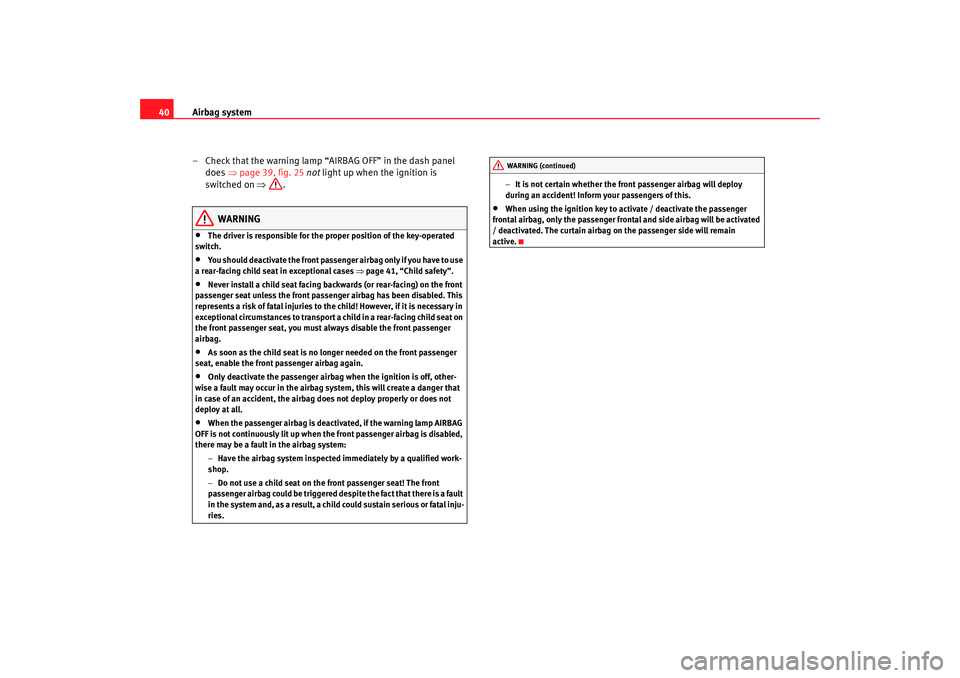
Airbag system
40
– Check that the warning lamp “AIRBAG OFF” in the dash panel does ⇒page 39, fig. 25 not light up when the ignition is
switched on ⇒.
WARNING
•
The driver is responsible for the proper position of the key-operated
switch.
•
You should deactivate the front passenger airbag only if you have to use
a rear-facing child seat in exceptional cases ⇒ page 41, “Child safety”.
•
Never install a child seat facing backwards (or rear-facing) on the front
passenger seat unless the front passenger airbag has been disabled. This
represents a risk of fatal injuries to the child! However, if it is necessary in
exceptional circumstances to transport a child in a rear-facing child seat on
the front passenger seat, you must always disable the front passenger
airbag.
•
As soon as the child seat is no longer needed on the front passenger
seat, enable the front passenger airbag again.
•
Only deactivate the passenger airbag when the ignition is off, other-
wise a fault may occur in the airbag system, this will create a danger that
in case of an accident, the airbag does not deploy properly or does not
deploy at all.
•
When the passenger airbag is deactivated, if the warning lamp AIRBAG
OFF is not continuously lit up when the front passenger airbag is disabled,
there may be a fault in the airbag system:
−Have the airbag system inspected immediately by a qualified work-
shop.
− Do not use a child seat on the front passenger seat! The front
passenger airbag could be triggered despite the fact that there is a fault
in the system and, as a result, a child could sustain serious or fatal inju-
ries. −
It is not certain whether the front passenger airbag will deploy
during an accident! Inform your passengers of this.
•
When using the ignition key to activate / deactivate the passenger
frontal airbag, only the passenger frontal and side airbag will be activated
/ deactivated. The curtain airbag on the passenger side will remain
active.WARNING (continued)
cordoba_ingles_0706 Seite 40 Montag, 28. August 2006 1:18 13
Page 55 of 256
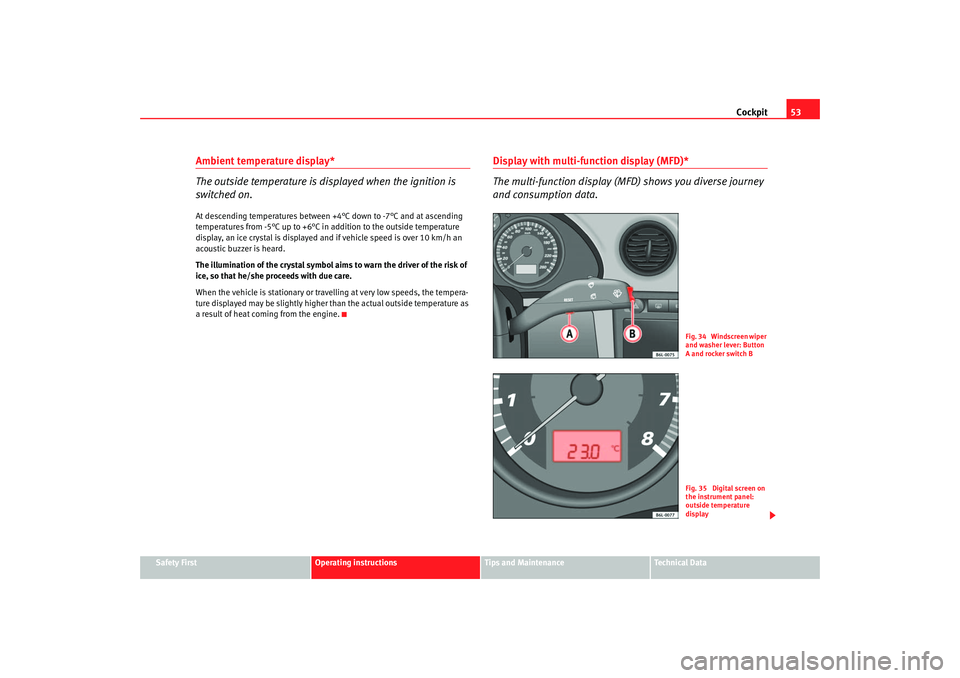
Cockpit53
Safety First
Operating instructions
Tips and Maintenance
Te c h n i c a l D a t a
Ambient temperature display*
The outside temperature is displayed when the ignition is
switched on.At descending temperatures between +4°C down to -7°C and at ascending
temperatures from -5°C up to +6°C in addition to the outside temperature
display, an ice crystal is displayed and if vehicle speed is over 10 km/h an
acoustic buzzer is heard.
The illumination of the crystal symbol ai ms to warn the driver of the risk of
ice, so that he/she proceeds with due care.
When the vehicle is stationary or travelling at very low speeds, the tempera-
ture displayed may be slightly higher than the actual outside temperature as
a result of heat coming from the engine.
Display with multi-function display (MFD)*
The multi-function display (M FD) shows you diverse journey
and consumption data.
Fig. 34 Windscreen wiper
and washer lever: Button
A and rocker switch BFig. 35 Digital screen on
the instrument panel:
outside temperature
display
cordoba_ingles_0706 Seite 53 Montag, 28. August 2006 1:18 13